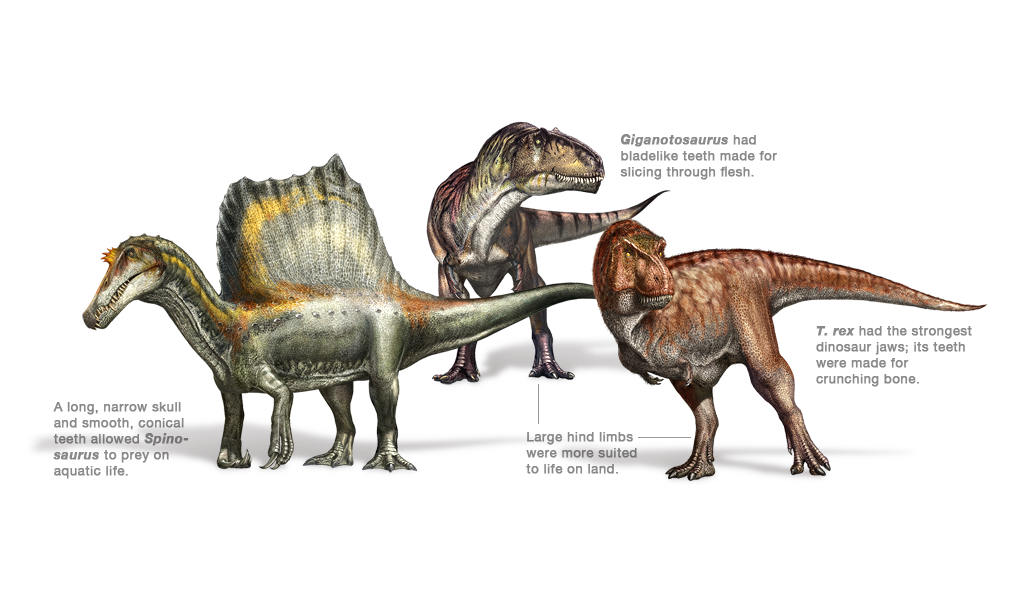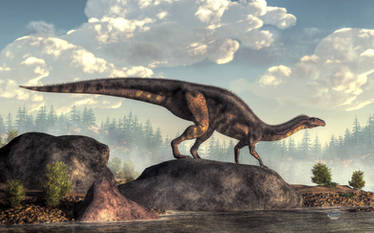ShopDreamUp AI ArtDreamUp
Deviation Actions
Description
With the discovery that Spinosaurus aegyptiacus was more aquatic than we realized (news.nationalgeographic.com/ne…), this adds a new element to one of the most contested debates in recent paleontology history: Who was the ultimate predatory dinosaur: Spino, Giga, or T. rex?
Spino was longer, but it's body was more low-slung than other large theropods; this made more vulnerable to attacks from above. It's large, clawed, well-muscled arms were formidable weapons. However, it's shorter legs meant Spino had to rear up to use them, exposing it's underbelly. Furthermore, Spino mostly would have stuck to the river systems in it's environment.
Giganotosaurus carolinii was slightly larger than T. rex, and weighed about the same, at 7-8 tons. A crucial difference, though, is Giga had a stockier build better suiting for tackling super-sized sauropods and chasing down iguanodonts. It's head was also built much like a hatchet, was used in a similar way to slash at it's prey. Giga's arms were also deadly killing tools, but lacked the same musculature of it's earlier cousins.
Tyrannosaurus rex is the most famous flesh-eating dinosaur, but also one of the last dinosaurs to live on Earth. Unlike most big theropods before it, T. rex lived in an environment that was almost devoid of large sauropods. Instead, most of it's prey was around the same size as itself or smaller, and many of these herbivores were armored in some manner. This forced T. rex to evolve a unique set of attributes not found in most other theropods.
* It's legs are long, with muscles bunched at the top. And the arctometatarsal (pinched foot bones) improves shock absorption while running.
* The arms are shrunken, reducing the weight of it's front. The two functional fingers could rotate away from each other, and larger than average muscle attachments show the arms weren't useless.
* T. rex's skull is wider and stronger than it's contemporaries. It's side teeth are shaped like railroad spikes for crushing bone and penetrating armor. A solid bony palette reinforces the skull against jostling.
* The tail of T. rex is deeper and thicker than those of it's cousins, and doesn't taper as much. This provides a heavy counterbalance for it's upper torso and huge head.
So, who do you think would win, or deserves more of the spotlight?
Image belongs to National Geographic ngm.nationalgeographic.com/201…
Spino was longer, but it's body was more low-slung than other large theropods; this made more vulnerable to attacks from above. It's large, clawed, well-muscled arms were formidable weapons. However, it's shorter legs meant Spino had to rear up to use them, exposing it's underbelly. Furthermore, Spino mostly would have stuck to the river systems in it's environment.
Giganotosaurus carolinii was slightly larger than T. rex, and weighed about the same, at 7-8 tons. A crucial difference, though, is Giga had a stockier build better suiting for tackling super-sized sauropods and chasing down iguanodonts. It's head was also built much like a hatchet, was used in a similar way to slash at it's prey. Giga's arms were also deadly killing tools, but lacked the same musculature of it's earlier cousins.
Tyrannosaurus rex is the most famous flesh-eating dinosaur, but also one of the last dinosaurs to live on Earth. Unlike most big theropods before it, T. rex lived in an environment that was almost devoid of large sauropods. Instead, most of it's prey was around the same size as itself or smaller, and many of these herbivores were armored in some manner. This forced T. rex to evolve a unique set of attributes not found in most other theropods.
* It's legs are long, with muscles bunched at the top. And the arctometatarsal (pinched foot bones) improves shock absorption while running.
* The arms are shrunken, reducing the weight of it's front. The two functional fingers could rotate away from each other, and larger than average muscle attachments show the arms weren't useless.
* T. rex's skull is wider and stronger than it's contemporaries. It's side teeth are shaped like railroad spikes for crushing bone and penetrating armor. A solid bony palette reinforces the skull against jostling.
* The tail of T. rex is deeper and thicker than those of it's cousins, and doesn't taper as much. This provides a heavy counterbalance for it's upper torso and huge head.
So, who do you think would win, or deserves more of the spotlight?
Image belongs to National Geographic ngm.nationalgeographic.com/201…
Image size
1024x605px 440.42 KB
© 2014 - 2024 DYnoJackal19
Comments35
Why not including Carcharodontosaurus? It was pretty big as well, very similar in size with Giganotosaurus. Where is Mapusaurus, which is a big animal, at least 41 ft long? I don't see Tyrannotitan, which is the second largest Theropod know from good specimen. Why not including Deinocheirus, which is pretty massive (plus, it had a very nice look, it's one of my favorite dinosaur now)? Where is Saurophaganax? Where is Therizinosaurus? Where is Oxalaia? I think that image is missing a lot of Theropods, which are big as well.
Comments have been disabled for this deviation
































